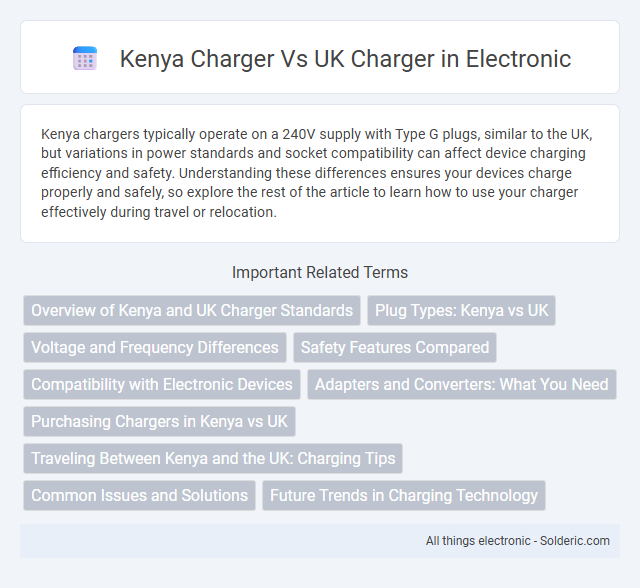Kenya chargers typically operate on a 240V supply with Type G plugs, similar to the UK, but variations in power standards and socket compatibility can affect device charging efficiency and safety. Understanding these differences ensures your devices charge properly and safely, so explore the rest of the article to learn how to use your charger effectively during travel or relocation.
Comparison Table
| Feature | Kenya Charger | UK Charger |
|---|---|---|
| Plug Type | Type G (British Standard) | Type G (British Standard) |
| Voltage | 230V | 230V |
| Frequency | 50 Hz | 50 Hz |
| Current Rating | 13A commonly | 13A commonly |
| Fuse | 3A to 13A fuse included | 3A to 13A fuse included |
| Socket Compatibility | Works with Type G sockets | Works with Type G sockets |
| Safety Standards | KS 164:2014 compliant | BS 1363 compliant |
| Common Usage | Domestic and commercial in Kenya | Domestic and commercial in the UK |
Overview of Kenya and UK Charger Standards
Kenya chargers primarily follow the British Standard BS 1363, featuring a Type G plug with three rectangular pins, operating at 240V and 50Hz frequency. UK chargers use the same BS 1363 standard, ensuring compatibility between Kenyan and UK devices without the need for adapters. Both countries maintain strict electrical safety standards, emphasizing fused plugs and robust insulation for consumer protection.
Plug Types: Kenya vs UK
Kenya uses predominantly Type G plugs with three rectangular prongs shaped in a triangle, matching the UK's standard plug system. Both countries operate on a similar voltage of 230V and frequency of 50Hz, ensuring compatibility for devices without needing voltage converters. Your UK charger will fit Kenyan sockets without adapters, but always check device specifications for safe usage across regions.
Voltage and Frequency Differences
Kenya chargers operate on a voltage of 240V with a frequency of 50Hz, which matches the UK's standard electrical supply, allowing most devices to be used interchangeably without voltage converters. Both countries use the British-style Type G plug, ensuring physical compatibility of chargers. However, travelers should verify that their device supports 240V to prevent damage when moving between regions.
Safety Features Compared
Kenya chargers typically operate at 240V and 50Hz, similar to UK chargers, but their safety standards may vary based on manufacturer certifications. UK chargers often comply with stringent BS1363 regulations, including built-in fuses and insulation requirements, ensuring enhanced protection against electrical faults. When using chargers, your best safety is guaranteed by choosing devices certified for your region's standards and equipped with overcurrent and short-circuit protection features.
Compatibility with Electronic Devices
Kenya chargers typically use a Type G plug with a voltage of 240V and frequency of 50Hz, matching the UK electrical standards, making most UK chargers compatible with Kenyan outlets. Your electronic devices designed for the UK market will generally work seamlessly in Kenya without the need for an adapter, provided they support 240V input. However, it's essential to check the voltage and plug type compatibility for devices from other regions to avoid damage or malfunction.
Adapters and Converters: What You Need
Kenya uses Type G electrical outlets with a standard voltage of 240V and a frequency of 50Hz, which is the same as the UK, so your UK charger will physically fit Kenyan sockets without an adapter. However, if your charger is designed for a lower voltage or different plug type, using a voltage converter or plug adapter may be necessary to ensure safe charging. Always check your device's voltage compatibility and have the correct Type G adapter or converter to avoid damage when traveling between Kenya and the UK.
Purchasing Chargers in Kenya vs UK
Purchasing chargers in Kenya often involves considering compatibility with the local 240V, 50Hz power supply and the UK-style Type G plugs used nationwide, ensuring devices are suited for this standard. In the UK, chargers are widely available with consistent Type G plug standards, making it easier to find certified products that comply with strict safety regulations such as BS 1363. Price differences may occur due to import taxes and availability, so consumers in Kenya often seek universal or travel adapters for versatility, while UK buyers typically choose chargers designed specifically for local outlets.
Traveling Between Kenya and the UK: Charging Tips
Kenya uses Type G plugs with a voltage of 240V and frequency of 50Hz, identical to the UK's electrical standards, allowing seamless use of UK chargers in Kenya without adapters. When traveling between Kenya and the UK, travelers should verify their device's compatibility with the 240V supply to avoid damage from voltage discrepancies common in other regions. Investing in a universal travel adapter with surge protection is advisable for users who carry multiple devices to ensure both plug fit and electrical safety.
Common Issues and Solutions
Kenya chargers typically operate at 240V and 50Hz, similar to UK chargers, but plug shapes differ, causing compatibility issues without an adapter. Common problems include overheating and slow charging due to low-quality cables or incorrect voltage use. Solutions involve using certified adapters, ensuring charger compatibility with device voltage requirements, and opting for high-quality, branded charging equipment to prevent damage and ensure fast charging.
Future Trends in Charging Technology
Kenya chargers increasingly adopt fast-charging technology compatible with global standards, aligning with the UK's advanced USB-C fast chargers that prioritize energy efficiency and universal compatibility. Both regions are investing in wireless and solar-powered charging innovations to support sustainable energy use and reduce dependency on traditional power sources. Emerging trends emphasize smart charging systems integrated with IoT to optimize energy consumption and enable remote monitoring and control of devices.
Kenya charger vs UK charger Infographic

 solderic.com
solderic.com